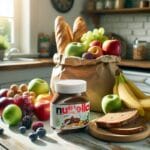Scan Your Food For E Numbers – Here’s How
Ever wondered what’s really inside your favorite snack? Whether you’re a label detective or just health-curious, scanning your food for E numbers is easier—and more important—than ever. Here’s how you can take charge of your food choices, laugh a little, and maybe even impress your friends at the grocery store.
What Are E Numbers? The Mysterious Codes in Your Food
E numbers are codes for substances—think additives, colorants, preservatives, and more—used in food products across the globe. The “E” stands for “Europe,” but these numbers are now a universal language on ingredient lists. For example, E100 is curcumin (from turmeric), while E621 is the infamous monosodium glutamate (MSG).
- Colorants: E100–E199
- Preservatives: E200–E299
- Antioxidants: E300–E399
- Thickeners, Stabilizers, Emulsifiers: E400–E499
- Acidity Regulators, Anti-caking Agents: E500–E599
- Flavor Enhancers: E600–E699
- Sweeteners, Others: E900–E1521
Why scan your food for E numbers? Because not all E numbers are created equal—some are harmless, others may trigger allergies, and a few are controversial. The European Food Safety Authority (EFSA) and the U.S. Food & Drug Administration (FDA) both regulate these, but their rules (and allowed additives) can differ.
Why Should You Care About E Numbers?
Imagine this: You’re at a party, eyeing a mysterious dip. Is it safe for your gluten sensitivity? Does it contain artificial colors your child reacts to? Or maybe you’re just trying to avoid a sugar crash. Scanning for E numbers gives you the power to know what you’re eating—no PhD in chemistry required.
- Food sensitivities: Some E numbers can trigger reactions in sensitive individuals1.
- Dietary preferences: Vegans, vegetarians, and those with religious dietary laws often need to avoid certain additives.
- Health concerns: Ongoing research links some additives to potential health risks2.
- Transparency: Knowing what’s in your food is just plain empowering.
According to a 2023 New York Times article, consumer awareness about food additives is at an all-time high, with more people scanning labels and using apps than ever before.
How to Scan Your Food for E Numbers: The Easy Way
Step 1: Download a Food Scanner App
Unless you have a photographic memory for three-digit codes, a food scanner app is your new best friend. Food Scan Genius (available at scangeni.us) lets you scan product barcodes and instantly see which E numbers are present, what they mean, and whether they fit your dietary needs.
Step 2: Scan the Barcode
Open the app, point your camera at the barcode, and—voilà!—you’ll get a breakdown of all E numbers in the product, with color-coded warnings for allergens, dietary restrictions, or controversial additives.
Step 3: Review and Decide
- Green: Generally safe
- Yellow: Use caution (may cause reactions in sensitive individuals)
- Red: Restricted or controversial (check with your doctor or nutritionist)
Bonus: Food Scan Genius lets you set up profiles for allergies, vegan/vegetarian preferences, and more—so you see only what matters to you.
“I used to spend ages squinting at labels in the supermarket. Now, I just scan and go. Food Scan Genius has made shopping so much less stressful—especially with my daughter’s food allergies!”
– Emily R., London, UK
Try Food Scan Genius today and take the guesswork out of your grocery run!
Ingredient Labels: US vs. EU—Why It Matters
| Feature | United States (FDA) | European Union (EFSA) |
|---|---|---|
| Labeling of E Numbers | Usually listed by chemical name (e.g., “Sodium Benzoate”) | Often listed by E number (e.g., “E211”) |
| Approved Additives | Some additives allowed in US are banned in EU (and vice versa) | Stricter on certain colorants and preservatives |
| Transparency | Ingredients must be listed, but not always as “E numbers” | E numbers are standardized and easy to spot |
| Recent News | FDA bans Red Dye No. 3 | EU tightens rules on titanium dioxide |
Why does this matter? If you travel, shop online, or eat imported foods, you may encounter different labeling systems. Scanning your food for E numbers helps bridge the gap—no matter where you are.
Are E Numbers Safe? What Science Says
Not all E numbers are bad news. Many are natural (like E300, vitamin C), while others are synthetic but well-studied. Both the FDA and EFSA regularly review scientific evidence to determine safety.
- Some additives are linked to allergic reactions or hyperactivity in children3.
- Others, like E250 (sodium nitrite), are controversial due to potential cancer risk when consumed in large amounts4.
- Many E numbers are harmless or even beneficial (e.g., antioxidants, vitamins).
The key? Stay informed and scan your food for E numbers—especially if you have sensitivities or want to avoid certain ingredients.
Common E Numbers to Watch Out For
| E Number | Name | Use | Notes |
|---|---|---|---|
| E102 | Tartrazine | Yellow colorant | Can cause allergies, banned in some countries |
| E211 | Sodium Benzoate | Preservative | Linked to hyperactivity in children |
| E621 | Monosodium Glutamate (MSG) | Flavor enhancer | May cause sensitivity in some people |
| E951 | Aspartame | Artificial sweetener | Not suitable for people with PKU |
| E120 | Cochineal | Red colorant | Derived from insects (not vegan/vegetarian) |
Want to avoid these? Scan your food for E numbers before you buy!
How Food Scan Genius Makes It Effortless
- Instant E number breakdown: See what’s in your food at a glance.
- Personalized alerts: Get warnings for your allergies, sensitivities, or dietary choices.
- Global database: Works for products in the US, UK, EU, and beyond.
- Scientific sources: Each E number links to trusted info from FDA, EFSA, and PubMed.
- Community reviews: See what other users say about products and additives.
Download Food Scan Genius and join thousands who scan their food for E numbers—because knowledge is delicious.
FAQs: Scan Your Food For E Numbers – Here’s How
- Q: What are E numbers and why do they matter?
- A: E numbers are standardized codes for food additives. They matter because some people have sensitivities, allergies, or dietary restrictions related to certain additives.
- Q: How can I scan my food for E numbers?
- A: Use a food scanner app like Food Scan Genius. Just scan the barcode, and the app will display all E numbers and what they mean.
- Q: Are all E numbers harmful?
- A: No, many are safe or even beneficial. However, some are controversial or may cause reactions in sensitive individuals.
- Q: Is Food Scan Genius available in my country?
- A: Food Scan Genius works with products in the US, UK, EU, and many other countries. Check scangeni.us for details.
Conclusion: Take Control of What’s on Your Plate
Whether you’re navigating allergies, following a specific diet, or just want to know what’s in your food, scanning for E numbers puts the power in your hands. With apps like Food Scan Genius, you can shop smarter, eat safer, and maybe even win a trivia night or two.
Understanding ingredients is the first step to better health—and a happier, more confident you. So next time you’re at the supermarket, don’t just read the label—scan it!





